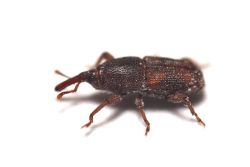Rice Weevil
 Description:
Description:
Rice weevils are pests of stored grain and seeds. It is a major pest of whole cereal grains. Weevils are tiny beetles that can infest grains and rice foods stored in your pantry, such as cake and biscuit mixes, pancake mixes, breakfast cereal, crackers, and more. Weevils can infest your food when female weevils have unnoticeably burrowed and laid eggs deep into the grain and rice kernels. Although infestation may be undetected at first, you may notice the tiny black beetles' weeks or months later after the eggs have hatched. There are steps you can take to prevent weevils from invading your pantry and infesting your other foods.
Appearance:
The adult rice weevil is 2.5 - 3.5 mm long and has a slender, hard-shelled body that appears pitted or scarred with tiny holes. They are brown-black in color and possess a long slender snout. Rarely flies, but climbs vertical surfaces. Rice weevils have four faint red-brown spots on the back of the abdomen.
Lifecycle:
Adults live 2-3 months. The egg, larva, and pupa stages of these weevils occur in the grain kernels and are rarely seen. Females drill a tiny hole in the grain kernel, deposit an egg in the cavity, then plug the hole with a gelatinous secretion. The egg hatches into a young larva which bores toward the center of the kernel, feeds, grows, and pupates there. New adults bore emergence holes from the inside, then leave to mate and begin a new generation. Female rice weevils lay between 300 to 400 eggs, with the life cycle requiring about 32 days for completion. Two larvae can develop in one wheat kernel.
Habits:
The adults can feign death by drawing up their legs close to the body, falling, and remaining silent when disturbed. Emergence holes of the rice weevil are smaller than those of the granary weevil, and tend to be smooth and round. There is generally no external evidence that the larvae have been eating and growing inside the seed until after about one month when the adult weevil chews through the seed coat and emerges. Under warm conditions or when grain is moved rice weevils are often observed climbing out of grain up vertical surfaces.